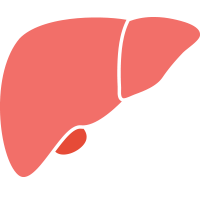
Hepatic Cell News
Hepatic Cell News is an online resource covering the top research on hepatocytes and liver diseases.
TMX2 Potentiates Cell Viability of Hepatocellular Carcinoma by Promoting Autophagy and Mitophagy
[Autophagy] Investigators performed a CRISPR activation screen targeting human genes encoding membrane-associated proteins, revealing TMX2 as a potential driver of HCC cell viability.
KLF4 Inhibits the Activation of Human Hepatic Stellate Cell In Vitro
[Current Medical Science] The authors designed a KLF4 lentiviral vector and a KLF4 siRNA lentiviral vector, to upregulate and silence KLF4 expression in human HSC LX-2 cells via transfection. Cell proliferation was assessed using the CCK-8 assay.
Proteo-Genomic Characterization of Cirrhosis-Associated Liver Cancers Reveals Potential Subtypes and Therapeutic Targets
[Clinical and Translational Oncology] The analysis revealed different subtypes of HCC associated with cirrhosis and identified several key genes, including CCNB2, MCM4, and CDC20, with strong binding power and prognostic value.
Impact of Rifaximin Use in Infections and Mortality in Patients with Decompensated Cirrhosis and Hepatic Encephalopathy
[Therapeutic Advances In Gastroenterology] Scientists evaluated the role of rifaximin in preventing frequent cirrhosis-related infection, Clostridioides difficile infection, and all-cause mortality, as well as determining adverse effects and adherence to the drug.
Nesfatin-1 and Nesfatin-1-Like Peptide Attenuate Hepatocyte Lipid Accumulation and Nucleobindin-1 Disruption Modulates Lipid Metabolic Pathways
[Nature Communications] Researchers determined if NLP, like NESF-1, regulated lipid accumulation in vitro, and tested if the disruption of nucb1 gene affects hepatic lipid metabolism genes in mice.
FGL1 and FGL2: Emerging Regulators of Liver Health and Disease
[Biomarker Research] Scientists provide an overview of the structure and roles of FGL1 and FGL2 in different liver conditions, emphasizing the intricate molecular regulatory processes and advancements in targeted therapies.
New US Liver Transplant Policy Raises Cost and Equity Concerns, According to New Study
[CNN] Changes to the policy that governs how liver transplants are allocated in the United States were meant to increase the number of transplants and make the process more equitable, but a new study raises concerns that it’s putting certain underserved communities at a greater disadvantage.
World First: Living Cancer Patient in China Receives Pig’s Liver Transplant
[South China Morning Post] In a world first, Chinese doctors said they transplanted a gene-edited pig’s liver into a living patient, the latest milestone in a record-setting year for researchers into animal-to-human transplants, known as xenotransplantation.
Selecting Serum-Free Hepatocyte Cryopreservation Stage and Storage Temperature for the Application of an “Off-the-Shelf” Bioartificial Liver System
[Scientific Reports] When hepatocyte spheroids were subjected to cryopreservation in a deep freezer, no statistically significant differences were observed in ammonia removal rate or urea secretion rate based on the cryopreservation period.
Patient-Reported Outcomes From the Phase III HIMALAYA Study of Tremelimumab Plus Durvalumab in Unresectable Hepatocellular Carcinoma
[Journal of Clinical Oncology] Participants were randomly assigned to receive STRIDE, durvalumab, or sorafenib. Preplanned secondary outcome were assessed using the European Organization for Research and Treatment of Cancer 30-item Quality of Life Questionnaire and the 18-item HCC module.
Multi-Omics Analysis of Macrophage-Associated Receptor and Ligand Reveals a Strong Prognostic Signature and Subtypes in Hepatocellular Carcinoma
[Scientific Reports] Researchers identified the macrophage-related receptor ligand marker genes associated with HCC and further explored the molecular immune mechanisms attributed to altered biomarkers.
AKR1B10 Expression Characteristics in Hepatocellular Carcinoma and Its Correlation with Clinicopathological Features and Immune Microenvironment
[Scientific Reports] The authors explored the expression characteristics of AKR1B10 in HCC and its correlation with clinicopathological features, survival prognosis, and tumor immune microenvironment, further investigating its role and potential regulatory mechanisms in HCC.
The publications featured in Hepatic Cell News are expertly selected by our in-house editorial team from high impact, peer-reviewed academic journals. We cover areas including the culturing and characterization of hepatocytes, liver stem cells, and the pathogenesis of conditions such as liver cirrhosis and hepatocellular carcinoma. Additionally, we provide the latest updates on broader news, upcoming events, and job postings to keep the global liver research community connected!

 Cancer Stem Cell News
Cancer Stem Cell News Cell Therapy News
Cell Therapy News Dermal Cell News
Dermal Cell News Endothelial Cell News
Endothelial Cell News ESC & iPSC News
ESC & iPSC News Extracellular Matrix News
Extracellular Matrix News Hematopoiesis News
Hematopoiesis News Hepatic Cell News
Hepatic Cell News Human Immunology News
Human Immunology News Immune Regulation News
Immune Regulation News
 Intestinal Cell News
Intestinal Cell News Mammary Cell News
Mammary Cell News Mesenchymal Cell News
Mesenchymal Cell News Muscle Cell News
Muscle Cell News Neural Cell News
Neural Cell News Organoid News
Organoid News Pancreatic Cell News
Pancreatic Cell News Prostate Cell News
Prostate Cell News Pulmonary Cell News
Pulmonary Cell News
